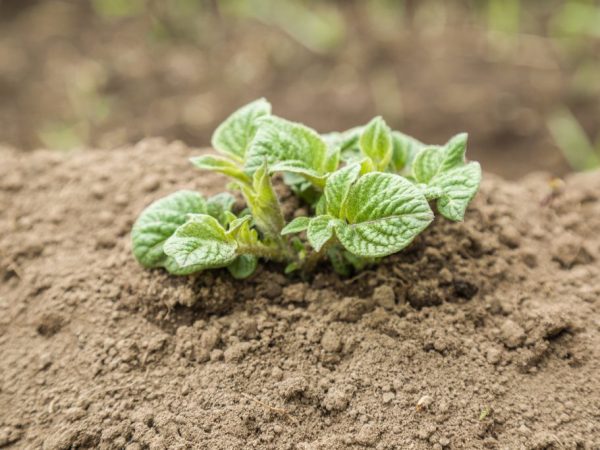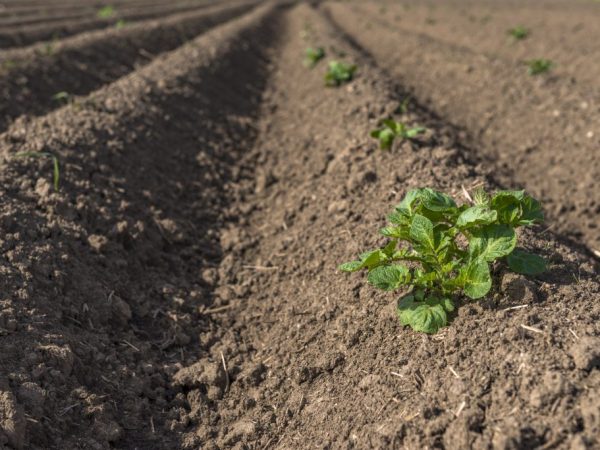How quickly potatoes emerge after planting
How many days do potatoes emerge after planting? To answer the question, let us analyze the factors on which the yield of such a crop depends.

Potatoes emerge after planting
Temperature regime
Well-warmed soil is one of the important indicators of successful seed hatching. If the soil is below 8 °, then you can not start agricultural work. To prevent the sprouts from freezing, it is necessary to determine the average daily temperature at a depth of 12 cm.
To determine the landing period, you can use folk signs. Root crops are buried in the ground after the flowering of perennial plants has begun, and at the birch the leaves have become the size of a penny.
If the ground warms up to 10 ° C, then the potatoes wake up within 25 days. With an increase in heat to 20 ° C, pecking occurs on day 15. An early harvest can be removed if sprouted tubers are planted. This option reduces the timeframe by a week from the variety declared by the manufacturer.
"For the southern regions, the onset of phase 1 (emergence of seedlings) in 20 days is in most cases a deviation from the norm, but for the northern regions this period is quite acceptable."
Planting depth can also affect germination. The earth is slowly warming up in the lower layers, which negatively affects growth. The thicker the soil layer above the seed, the longer it takes to develop. In addition, pecking depends on soil moisture. Wet soil does not hold the temperature well and does not allow air to pass through, the tubers rot from a lack of heat and oxygen.
Uneven shoots
It happens that potatoes rise for a long time and unevenly. If the temperature norms were not violated during planting, then you should understand other reasons:
- Different shapes of tubers. Large specimens need more time to germinate, and small ones hatch first. Small seeds give non-viable shoots that die quickly.
- Mix of varieties. Each species has its own timing of development, so the processes appear unevenly. If the potato has risen unevenly, then this is an indicator of the farmer's inattention.
- Depth. Landing is carried out according to a strictly selected scheme. If the holes are not the same size, then the tops will hatch with a delay.
- Uneven germination.
If you plant potatoes according to the rules, then the likelihood of a problem is reduced to zero. The longer a person spends time in the first days, the less trouble awaits in the future. Errors are difficult to fix, they can only be prevented in the initial stages.
Planting procedure

Good germination
In order for the planted potatoes to rise on time, you need to ensure proper preparation for planting and care for the crop. All work begins in autumn and continues throughout the growing season.
Plot
Potatoes prefer to grow in nutritious soil, so humus is added to the ground during digging. For normal development, one bucket per 1 sq. M is enough. In the spring, the soil is thoroughly plowed, removing plant residues.The lack of trace elements affects not only fertility, but also the germination of raw materials.
When choosing a site, give preference to a well-lit place. In the shade, the culture does not develop well, the timing of hatching from seeds may shift. Do not forget about the rules of crop rotation - do not plant vegetables after nightshade species. Recommended predecessors:
- siderates;
- zucchini;
- garlic;
- legumes.
A week before disembarkation, you can start breaking the beds. Remember that the plant will not give a bountiful harvest in too dense soil, therefore it is necessary to "dilute" the structure with sand. At the bottom of each hole, two tablespoons of superphosphate are poured, after which the plantation is covered with polyethylene.
Preparation of raw materials
To get a good harvest of potatoes, you need to take only high-quality varietal seeds. Under favorable conditions, potato shoots appear a month after planting. However, there are varieties of the popular root vegetable that will delight you with a bountiful harvest 6 weeks after burying in the ground. If you want to get young potatoes, then we recommend opting for early ripening and ultra-early varieties.
They start harvesting in the fall after the last harvest. Correct, even tubers are selected, without damage or stains. Raw materials are left under the scattered sun for greening for several days. Such fruits are perfectly stored until the next season, and low-quality specimens appear immediately.
In the spring, the sorted and sorted seeds are transferred to a room with access to light and a temperature of 15 to 20 C. We advise you to lay out the products in two layers on racks or in vegetable boxes. After 3 weeks, shoots with roots appear on the potatoes. Before starting work, remove all non-germinated specimens or those having an irregular shape (single, threadlike).
If there is no time to engage in sprouting potatoes, then you can give preference to warming up. The procedure begins 10 days before planting in the ground. For this, the raw materials are left in the dark at an elevated temperature of 18-20 C. A longer stay in such conditions leads to the formation of long shoots that break off when buried in the ground.
To protect against diseases and enhance growth, they are soaked in chemical solutions. For ailments and parasites, they are sprayed with insectofungicidal preparations ("Maxim", "Prestige"). After the material dries out, it is soaked in a stimulator (Epin, Vermistim). Biologically active substances of the means "wake up" the root crops, as a result of which the plants form faster.
Large tubers take longer to germinate than small ones. Huge fruits for a long time form large bushes with a highly developed root system. If you do not want to get giant specimens, then give preference to medium-sized raw materials - no more than a chicken egg.
You cannot take tubers without eyes, otherwise you can not wait for seedlings at all. Potatoes should be healthy, without cracks or dents. In addition, it is forbidden to store seed in white plastic bags. Under these conditions, biting is zero.
To ensure the health of the raw material, we recommend cutting two potatoes for inspection. Additionally, attention is paid to the sprouts of sprouted tubers. Shoots should be short and thick. The longer the twigs, the more likely they are to break during transport or planting.
Landing
In order for the potato to sprout, it is necessary to bury it to a depth of 8 to 10 cm, the recommended planting scheme is 80x35 cm. Some gardeners prefer to place tubers more densely, but densely planted vegetation will interfere with development. The tops are poorly blown by the wind, which increases the likelihood of getting sick with late blight.
The first hilling is carried out after the shoots reach 10 cm. Carefully sprinkle the bushes with soil, which is collected next to the garden bed.The plant takes root deeper into the ground, which will be an excellent protection against frost and will help to get a bountiful harvest.
As soon as the tops grow up to 40 cm, a second hilling can be carried out. In order not to expose the underground parts, it is necessary to thoroughly cover it with soil. At the same time, the rows are weeded, removing the weeds. To facilitate further care, the plantings are mulched with sawdust.
When growing root crops, it is important to adhere to the rules of agricultural technology. Knowing how many days potatoes grow, you can provide the most comfortable conditions for a crop such as potatoes.

